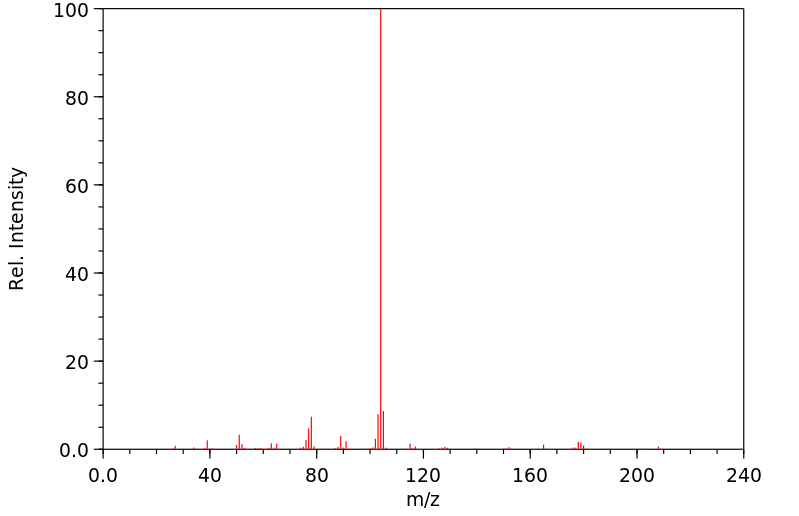trans-1,2-Diphenyl-cyclobutan
中文名称
——
中文别名
——
英文名称
trans-1,2-Diphenyl-cyclobutan
英文别名
trans-1,2-diphenylcyclobutane;(1S,2S)-1,2-diphenylcyclobutane;[(1S,2S)-2-phenylcyclobutyl]benzene
CAS
——
化学式
C16H16
mdl
——
分子量
208.303
InChiKey
AERGGMDNGDDGPI-HZPDHXFCSA-N
BEILSTEIN
——
EINECS
——
-
物化性质
-
计算性质
-
ADMET
-
安全信息
-
SDS
-
制备方法与用途
-
上下游信息
-
文献信息
-
表征谱图
-
同类化合物
-
相关功能分类
-
相关结构分类
计算性质
-
辛醇/水分配系数(LogP):4.6
-
重原子数:16
-
可旋转键数:2
-
环数:3.0
-
sp3杂化的碳原子比例:0.25
-
拓扑面积:0
-
氢给体数:0
-
氢受体数:0
上下游信息
-
上游原料
中文名称 英文名称 CAS号 化学式 分子量 顺式-1,2-二苯基环丁烷 cis-1,2-diphenylcyclobutane 7694-30-6 C16H16 208.303
反应信息
-
作为反应物:描述:参考文献:名称:芳香腈对 1,2-二苯基环丁烷的单光敏化环裂化和异构化反应。对 EXCIPLEX 中间体的反应性和电子性质之间关系的可能探索摘要:顺式 1,2-二苯基环丁烷与 1,4-二氰基萘和 9,10-二氰基蒽的光敏反应得到苯乙烯、反式异构体和 1-苯基四氢萘,而 1-氰基萘的光敏反应则产生环裂和顺,反-异构化反应而不形成 1-苯基四氢化萘。反式异构体的类似反应被芳香腈光敏化,但没有发生反式,顺式异构化。根据不同电荷转移和激发共振贡献的激基复合中间体讨论了反应的特征。DOI:10.1246/cl.1984.1847
-
作为产物:描述:参考文献:名称:Proton catalyzed cis-trans stereomutation of cis-1,2-diarylcyclobutanes摘要:DOI:10.1021/ja00275a073
文献信息
-
Photosensitised regioselective [2+2]-cycloaddition of cinnamates and related alkenes作者:Santosh K. Pagire、Asik Hossain、Lukas Traub、Sabine Kerres、Oliver ReiserDOI:10.1039/c7cc06710k日期:——An efficient method for the synthesis of substituted cyclobutanes from cinnamates, chalcones, and styrenes has been developed utilizing a visible-light triplet sensitisation mode. This reaction provides a diverse range of substituted cyclobutanes in high yields under mild conditions without the need of external additives. Good regioselectivity is obtained due to strong π–π-stacking of arene moieties
-
Visible light-induced highly selective transformation of olefin to ketone by 2,4,6-triphenylpyrylium cation encapsulated within zeolite Y作者:Yasuhiro Shiraishi、Naoya Saito、Takayuki HiraiDOI:10.1039/b515137f日期:——2,4,6-Triphenylpyrylium cation encapsulated within zeolite Y promotes highly selective transformation of olefins to ketones with molecular oxygen, under visible light (lambda > 400 nm) irradiation at room temperature.在室温下在可见光(λ> 400 nm)照射下,包裹在沸石Y中的2,4,6-三苯基吡啶鎓阳离子可促进烯烃与分子氧的高选择性转化为酮。
-
The synthesis of cycloalkanes via anionic coupling reactions作者:D. H. Richards、N. F. ScillyDOI:10.1039/j39690002661日期:——A number of cycloalkanes have been isolated among the products of the reactions of geminal and vicinal dihalides with dimeric dianions produced from substituted styrenes by the action of lithium. The n.m.r. and mass spectra of the products are reported.
-
Quantum Dots Photocatalyze Intermolecular [2 + 2] Cycloadditions of Aromatic Alkenes Adsorbed to their Surfaces via van der Waals Interactions作者:Yishu Jiang、Rafael López-Arteaga、Emily A. WeissDOI:10.1021/jacs.2c00833日期:2022.3.9mild and selective route to cycloadditions, radical rearrangements, couplings, fragmentations, and isomerizations. Colloidal quantum dots are proven visible-light photosensitizers and structural scaffolds for triplet-initiated reactions of molecules that are functionalized (with carboxylates) to anchor on the QD surface. Here, with the aid of polyaromatic energy shuttles that act as noncovalent adsorption三重激发态引发的光化学是一种温和且选择性的环加成、自由基重排、偶联、断裂和异构化途径。胶体量子点被证明是可见光光敏剂和结构支架,用于功能化(用羧酸盐)锚定在 QD 表面的分子的三重引发反应。在这里,借助作为 QD 表面上底物的非共价吸附位点的多环能量穿梭,QD 光催化的分子间 [2 + 2] 环加成的范围扩展到自由扩散的底物(无锚定基团)。QD-穿梭配合物光催化苯扎丙酮、查耳酮及其衍生物的同型和异型分子间 [2 + 2] 光环加成反应,产率高达 94%;3,但具有 2.5 倍的催化剂负载量低、稳定性好、能够通过简单的离心回收催化剂并将其重复用于多个反应循环的优点。实验暗示了两步三重态-三重态能量转移机制,一个能量从 QD 转移到能量穿梭,然后第二个能量从穿梭转移到瞬时吸附的基板。
-
Thermal Ring-Splitting Reactions of Diarylcyclobutanes: Significance of Steric Effects on Orbital Interactions in Transition States and Biradical Intermediates作者:Masahide Yasuda、Kouhei Yoshida、Kensuke Shima、Chyongjin Pac、Shozo YanagidaDOI:10.1246/bcsj.62.1943日期:1989.6Regiochemistry and reactivities in the thermal ring-splitting reactions of diarylcyclobutanes (1–5) have been studied and shown to depend on the stable conformations and rotational mobilities of the aryl substituents. The reactions of 1 and 2 result in a regiospecific symmetric cleavage to give indene or styrene along with significant isomerization of 2 to 3. In the cases of 3–5 both the symmetric and unsymmetric
表征谱图
-
氢谱1HNMR
-
质谱MS
-
碳谱13CNMR
-
红外IR
-
拉曼Raman
-
峰位数据
-
峰位匹配
-
表征信息
同类化合物
(E,Z)-他莫昔芬N-β-D-葡糖醛酸
(E/Z)-他莫昔芬-d5
(4S,5R)-4,5-二苯基-1,2,3-恶噻唑烷-2,2-二氧化物-3-羧酸叔丁酯
(4S,4''S,5R,5''R)-2,2''-(1-甲基亚乙基)双[4,5-二氢-4,5-二苯基恶唑]
(4R,5S)-4,5-二苯基-1,2,3-恶噻唑烷-2,2-二氧化物-3-羧酸叔丁酯
(4R,4''R,5S,5''S)-2,2''-(1-甲基亚乙基)双[4,5-二氢-4,5-二苯基恶唑]
(1R,2R)-2-(二苯基膦基)-1,2-二苯基乙胺
鼓槌石斛素
黄子囊素
高黄绿酸
顺式白藜芦醇三甲醚
顺式白藜芦醇
顺式己烯雌酚
顺式-白藜芦醇3-O-beta-D-葡糖苷酸
顺式-桑皮苷A
顺式-曲札芪苷
顺式-二苯乙烯
顺式-beta-羟基他莫昔芬
顺式-a-羟基他莫昔芬
顺式-3,4',5-三甲氧基-3'-羟基二苯乙烯
顺式-1-(3-甲基-2-萘基)-2-(2-萘基)乙烯
顺式-1,2-双(三甲基硅氧基)-1,2-双(4-溴苯基)环丙烷
顺式-1,2-二苯基环丁烷
顺-均二苯乙烯硼酸二乙醇胺酯
顺-4-硝基二苯乙烯
顺-1-异丙基-2,3-二苯基氮丙啶
非洲李(PRUNUSAFRICANA)树皮提取物
阿非昔芬
阿里可拉唑
阿那曲唑二聚体
阿托伐他汀环氧四氢呋喃
阿托伐他汀环氧乙烷杂质
阿托伐他汀环(氟苯基)钠盐杂质
阿托伐他汀环(氟苯基)烯丙基酯
阿托伐他汀杂质D
阿托伐他汀杂质94
阿托伐他汀杂质7
阿托伐他汀杂质5
阿托伐他汀内酰胺钠盐杂质
阿托伐他汀中间体M4
阿奈库碘铵
锌(II)(苯甲醛)(四苯基卟啉)
银松素
铜酸盐(5-),[m-[2-[2-[1-[4-[2-[4-[[4-[[4-[2-[4-[4-[2-[2-(羧基-kO)苯基]二氮烯基-kN1]-4,5-二氢-3-甲基-5-(羰基-kO)-1H-吡唑-1-基]-2-硫代苯基]乙烯基]-3-硫代苯基]氨基]-6-(苯基氨基)-1,3,5-三嗪-2-基]氨基]-2-硫代苯基]乙烯基]-3-硫代
铒(III) 离子载体 I
铀,二(二苯基甲酮)四碘-
钾钠2,2'-[(E)-1,2-乙烯二基]二[5-({4-苯胺基-6-[(2-羟基乙基)氨基]-1,3,5-三嗪-2-基}氨基)苯磺酸酯](1:1:1)
钠{4-[氧代(苯基)乙酰基]苯基}甲烷磺酸酯
钠;[2-甲氧基-5-[2-(3,4,5-三甲氧基苯基)乙基]苯基]硫酸盐
钠4-氨基二苯乙烯-2-磺酸酯







